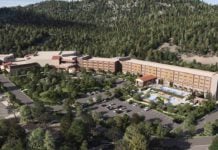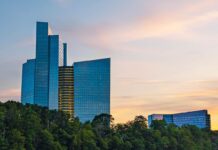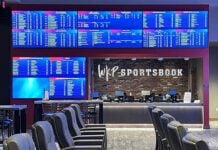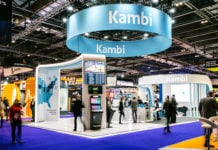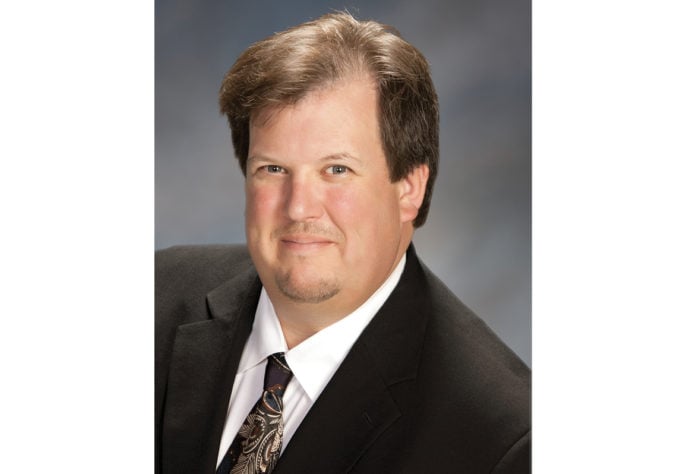Chris Creasey is Director at Tutor Perini Building Corp, a company that has built over $6 billion worth of properties in Indian Country. With over 23 years in the industry, Creasey shares his unique perspectives and insights on how tribes can stay ahead of the curve in their development projects. Here is what he had to say…
What do you feel are the most important elements in helping tribes plan and achieve their vision?
The big key is the master plan – the ideal dream of what a property will be. Occasionally, you may see people be shortsighted and say, ‘I need to build a casino right away,’ without putting any forethought into what that casino will evolve into. Will it be one hotel tower or three hotel towers someday? That’s the biggest thing – helping the client understand truly what their vision is and what the master plan should be.
What are some common challenges you see clients run into while expanding a property or handling a new build?
Let’s touch on an expanding property first. One of the biggest challenges is, how do you retain your current clientele while you’re tearing apart amenities, and making it somewhat inconvenient for that clientele to visit your property? It’s important for us to help with that vision of the customer experience. How do you enhance that customer experience while you’re building something? Is it signage? I’ve seen tribes say, ‘Look through the window here and see what exciting things that are coming.’ It’s important to build excitement about your expansion that gets people pumped up. It’s also important to look at how a customer enters a property and what they see – try to make it as convenient as possible for them. We had a project where we were tearing apart the front door, and for 15 months, that front door was changing. However, our client never saw a dip in revenue because they were able to give a pleasant experience to their customers.
On a new build, it’s easier due to the fact you’re not dealing with something existing that’s there. You’ve got your open space. Each project will have its own challenges, but it’s not as tough as it is when you’re expanding an existing property.
With so much money at stake and many different parties working together, how is good communication maintained?
It starts with building a team and getting everyone to buy into the same philosophy. You must have that communication up front before there’s any issues. That way, when issues arise that are challenging, everyone can talk openly, and it makes it easier. If you don’t have that great team out of the gate, if you’re not trusting of that contractor or that architect or the owner – all three parties – you will never have good communication throughout the project.
There are certain clients that we’ve had where we’ve done $800 million of work for them over 20 years. I’m not saying those projects were perfect, but we had a good team, and when there was a problem, the team addressed it and communicated, and it was resolved.
With material costs escalating on an ongoing basis, how can tribes and all parties involved stay within budget when projects take many months or years to complete?
Early procurement and getting your contractor on board before your design is complete. If we know what size the electrical switch gear is going to be early on, we can buy that and lock in that price. The other thing besides pricing is lead times. For instance, some electrical switch gear is out 70 weeks. If you’ve got a 52-week build and it’s 70 weeks to get your equipment, you need to procure that equipment earlier. The sooner you can procure your contractors and subcontractors and lock into pricing, the better. The challenge with that is, if you’re placing orders, that means you’ve got to start paying the bills right away. It is a double-edged sword. People can risk it and say, ‘Oh, we’ll just wait and see what happens.’ What we’re seeing more and more of is tribes procuring the long lead items and the high volatile cost items sooner rather than later.
Fortunately, commodity pricing has really leveled out. The costs of screws, pipe and wire have balanced out. It’s the larger equipment that is the challenge right now. A while back, we had a restaurant build that was six months, and the client wanted to have a particular soft serve ice cream machine that was 52 weeks away. So, we said, ‘do one of two things – open without the ice cream machine or don’t start construction for six months.’ They chose to wait for the soft serve machine.
Since your time with the company, what is the largest project in Indian Country Tutor Perini has been involved with?
That is tough. I can list a couple of the very large ones. I don’t know exactly which one is the largest, but they would include the second phase of Mohegan Sun that we did early 2000s, and the work we’ve done at Pechanga over the years. I would say the largest that we’ve done recently is the expansion at the Choctaw Casino & Resort – Durant with a new hotel and podium areas. Looking at our business in Indian Country overall, we’ve put in place over $6 billion worth of hotels and casinos. It’s a big number.
Regarding the most recent large project at Durant, how would you say challenges that arose during construction were dealt with on that project?
The first challenge was COVID. That happened right in the middle of the project. There were a couple other challenges, but they were dealt with by having great communication with the design team, which actually worked for us, and the owner group at Choctaw working together. Because of COVID, a bunch of things popped up. And we worked together to find the best course of action to move forward. We still opened that project on time, even though we were struggling to get workers on site because of COVID testing. It goes back to the earlier discussion about communication. That’s how we solved the problems.
What was the ultimate outcome of the project?
It is a beautiful, stunning property that opened on time and within budget. They were so happy with us that we are out there remodeling the existing property now. It goes back to a client relationship that is very strong. They are pleased with the communication from our team, and us delivering on what we said we would do.
What are you most proud of working at Tutor Perini?
I’m always excited about the uniqueness of what we build. In the commercial market, I can say we’ve built an Egyptian pyramid, an Eiffel Tower and a Roman Coliseum, where other guys may say, ‘Well, we built a Costco warehouse,’ or ‘we built a gas station.’ It’s the constant opportunity to say, ‘I’m building something that somebody dreamed about – someone’s vision.’ With the Native American market, we really are capturing their traditions, histories and visions in these projects that we build. For instance, Mohegan Sun with the Wombi Rock built inside; and Pechanga featuring important artifacts and replicas of their old canoes for guests to learn about. Building these projects gives them the means to go and do other things for their community. So, for us to go out there and assist in building that revenue generator to help them help their tribe, that’s one of the things we are most proud of. Great communication leads to great things.
For more information about Tutor Perini Building Corp, visit www.tutorperinibuilding.com.






